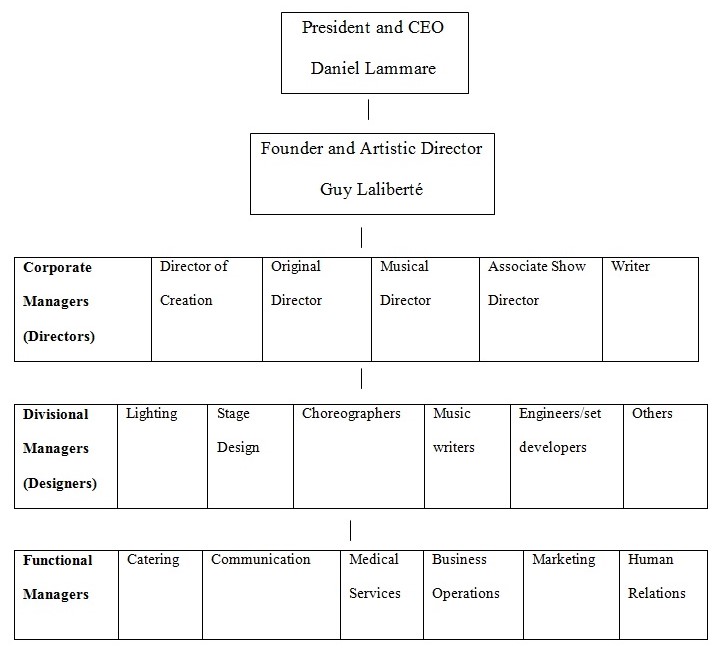Introduction
Cirque du Soleil is one of the worldwide known organizations in the entertainment field that has been offering its services during the last 37 years. It is characterized by a variety of well-planned strategies and approaches. According to its head of Enterprise Architecture, Marc Gagnon, the key success factors include technology, creativity, and innovation (as cited in Ghazzawi, 2019). However, enterprise management usually consists of different elements like organizational structure, leadership, and human resources. In most cases, managers have to adjust their company’s structures in regard to “the perceived market pressures” (Döhler, 2017, p. 88). Therefore, the creation of a multidivisional structure is a solution that requires thorough analysis and evaluation. In this essay, attention will be paid to be benefits and shortages of the multidivisional structure in Cirque du Soleil. Despite the possible disadvantages like isolation or power centralization, Cirque du Soleil properly employs its advantages of control, authority, and quick responses to changes in business development and competitive advantage maintenance.
Multidivisional Structure
When an individual or a group of people make a decision to create an organization, it is hard to predict its success and potential development. In 1984, 20 street performers roamed the streets of Baie-Saint-Paul with the purpose of entertaining the public, dancing, playing music, and performing amazing acrobatic stunting (“About cirque,” n.d.). Today, this theater group is known as the creators of Cirque du Soleil, where more than 1,300 artists from different countries show their talents, and 4,000 employees control performances around the globe (About cirque,” n.d.). To promote effective cooperation, Cirque du Soleil chooses a multidivisional organizational structure. It means that there are many divisions in a company defined by the offered products, services, and even geographical locations (MacKay et al., 2020). An efficiently developed structure introduces “a formal system of task and job reporting relationships that determines how employees use resources” to achieve goals (George & Jones, 2012, p. 470). The factors and conditions under which people should work are assessed to make sure that the right individual takes the right place.

As it is shown in Figure 1, Cirque du Soleil managed to introduce a good example of a multidivisional structure. There are two evident leaders who make first and final decisions (Ghazzawi, 2019). A team of corporate managers or creative directors analyzes the purposes, resources, and current trends. Finally, a group of functional managers deals with auxiliary services within the organization (Ghazzawi, 2019). Each group of managers is aware of their tasks and completes them in a timely manner, defined by the President and Artistic Director.
Advantages
Multidivisional structures create a number of benefits for organizations due to the possibility to focus on coordination, motivation, or resources. In the case under analysis, Cirque du Soleil benefits from its structure in marketing, fundraising, and attracting the attention of the necessary stakeholders (Ghazzawi, 2019). Increased effectiveness is promoted through the possibilities of corporate managers to be responsible for their long-term goals and divisional (functional) managers to complete routine (daily) operations. Another positive aspect is the development of centralized decision-making processes: although many people contribute to every performance in a unique way, the President and Artistic Director do not rely on traditional brainstorming techniques. They set a theme of the next show, listen, analyze, review the progress, and offer final thoughts. Empowerment is high appreciated within the established theme, and all employees have the autonomy to do everything they can (Ghazzawi, 2019). This approach allows compensating conflicting interests and organizing everything quickly and with benefits (Döhler, 2017). As a result, increased control and profitable growth are inherent to Cirque du Soleil with the chosen structure.
Disadvantages
Despite the intention to predict challenges and solve problems quickly, such disadvantages as poor coordination between divisions and managing working relationships cannot be ignored. In the cirques, employees are encouraged to cooperate with the outside world and embrace ideas from everywhere (Ghazzawi, 2019). Therefore, it is important to keep a balance between centralized and decentralized decisions. Sometimes, the offered ideas do not meet the possibilities, and instead of cooperating, employees have to compete for resources. Operating costs are hardly predictable, and the author must investigate each idea to make the correct choice and fund properly (George & Jones, 2012). The challenge of balancing and meeting financial expectations creates additional difficulties for leaders.
Conclusion
In general, the idea of multidivisional structures attracts much attention among large organizations, and the case of Cirque du Soleil shows evident pros and cons of this solution. On the one hand, centralized decision-making, cooperation with the outside world, and non-traditional brainstorming help the organization to stay competitive and unpredictable in the chosen field. On the other hand, financial costs and the lack of control between divisions create certain problems for leaders. Cirque du Soleil demonstrates good results due to its strategies based on innovation, technology, and creativity. At this moment, the example of this company can be applied in the development of small and large businesses.
References
About cirque. (n.d.). Cirque du Soleil. Web.
Döhler, M. (2017). The bias of structures: How multidivisional organizations work in the public sector. Public Organization Review, 17(1), 83-100.
George, J. M., & Jones, G. R. (2012). Understanding and managing organizational behavior (6th ed.). Prentice Hall.
Ghazzawi, I. (2019). Cirque du Soleil: Innovation is more culture than process. Journal of Case Research and Inquiry, 5, 201-236.
MacKay, B., Arevuo, M., Meadows, M., & Mackay, D. (2020). Strategy: Theory, practice, implementation. Oxford University Press.
